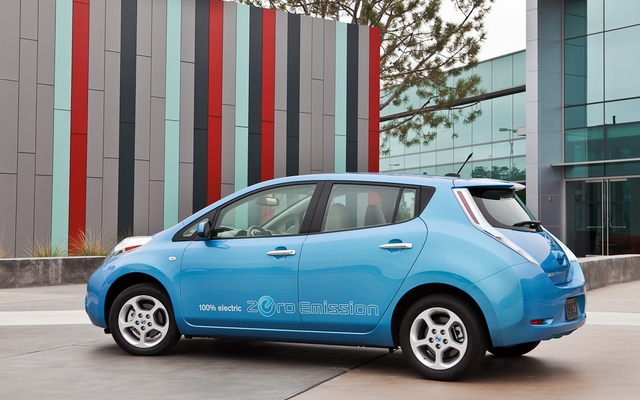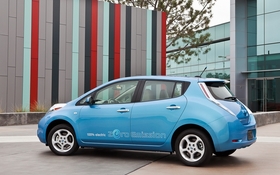2011 Nissan Leaf: 100% pure electric
Franklin, Tennessee. Having graced certain American markets already, the Nissan Leaf is set to hit Canadian roads in fall 2011. I had the chance to try the production model of this car, which does everything in its power to make you forget that it "fuels up" on electrons only.
Throughout my career as an auto journalist, I’ve had the chance to drive all kinds of electric cars, including a Versa prototype powered by the Leaf’s electric engine, as well as a Mitsubishi i-Miev, a Smart Electric Drive, a Tesla Roadster and a few others. But I can safely say that the one that drives most like a conventional car is the production model of the Nissan Leaf.
Aerodynamic design
The Leaf is a compact car with front-wheel drive that seats five and has five doors. In general, its looks are conventional, but when you look a little closer, you notice that it has been expertly designed to be aerodynamic. And since the Leaf is totally electric, its engine makes almost no noise, which means that any other sounds (wind, tires against the road, etc.) are all the more perceptible. They’re simply not blocked out by an internal combustion thermal engine. To reduce wind noise, Nissan engineers gave the Leaf a drag coefficient of 0.29. That’s quite remarkable given that it’s a compact five-seater and not a sports car. During development tests, the engineers even tweaked the headlamp design to give them a ridge which splits the airflow, directing it around the side rear-view mirrors. This creates less turbulence and reduces wind noise when running at highway speeds.
Slide into the Leaf and you’ll see for yourself that the interior is rather conventional, except for the high-tech dashboard and lack of a gear shifter. Starting the car is simple: simply put your foot on the brake pedal then push the stop/start button. This activates the dashboard display and a signal to let you know that the Leaf is ready to rumble. Then you engage drive or reverse mode via a control on the centre console that looks something like a hockey puck. And you’re off! Basically, starting the Leaf is surprisingly easy. Smartphone users won’t have to get up to charge the Leaf, as they will be able to set charging functions or monitor the vehicle’s charge using their intelligent cell phone.
On the road
As soon as the Leaf is in motion, it will charm with its torque. It goes from 0 to 50 km/h in almost complete silence with the confidence of a compact powered by a V6. Maximum torque is achieved right from the initial acceleration. Once you go over 50 km/h, its accelerations become less impressive. The Leaf weighs in at 1,500 kg, and its engine offers 80 kW, which is the equivalent of 107 hp and and 206 lbs.-ft. of torque. And yet, merging onto the highway is no problem, and the vehicle’s maximum speed is 140 km/h. On side roads, the steering proves to be precise and linear. Meanwhile, the regenerative brakes are less agressive than on other electric cars, offering flexible decelerations that make you feel like you’re in a conventional car – except that each deceleration recharges the battery. In other words, the Leaf behaves just like a conventional car, except that there’s no engine sounds. It comes equipped with ABS brakes, electronic traction control, electronic stability control and six airbags.
What about its autonomy?
The Leaf’s lithium-ion battery pack offers 24 kW/hr. Made up of 48 modules and weighing in at 250 kg, it sits inside the floor of the passenger compartment. Nissan claims that its range is 160 km, and the driver is constantly updated on how much further the battery will last. The circular "expected reachable area map display" appears on the screen of the satellite-assisted navigation system. Nissan guarantees the battery pack for 8 years or 160,000 km, but it is expected to last 10 years. Note that Nissan has struck a partnership with Sumitomo to develop a second-life program for these batteries. It’s also worth noting that Nissan’s original plan was to sell the car but lease the battery, but this plan has been scrapped. The battery is now part of the car’s equipment, which the consumer has to buy.
For cold-weather driving, Nissan advertises a range of 100 km. This is based on tests in Finland that considered an average speed of 30 km/hr and an outside temperature of less than 10 degrees Celsius, requiring maximum use of the heating system. These figures lead us to conclude that you could drive a Leaf in the Canadian winter to go from your suburban home to work and back without too much trouble, since 90% of Canadian drivers cover less than 60 km per day, according to Statistics Canada.
Recharging the batteries can be done in a few ways. The less interesting alternative is to plug it into a conventional 120-volt (1.4 kW) outlet, as this will take 20 hours to recharge it. The best option is to install a 240-volt (3.3 kW) charging station (this is the same amount of power used by your electric range or dryer), at which it only takes 8 hours to recharge. Most users will choose the second option. It’s also possible to charge the Leaf on a 50-kW continuous circuit quick charger, which brings the battery up to 80% of its capacity within 30 minutes.
How much?
At today’s electricity rates, driving a Leaf for a year (20,000 km) will set you back $180, compared to $1,200 for gas (based on a compact averaging 8.0 litres per 100 km). Plus, different provinces offer discounts or grants to buyers. If you think you’d rather lease a Leaf, the tax credit will be calculated according the lease term as follows:
12 to 24 months = 25% of total (i.e.: 25% of $8,000=$2,000)
24 to 36 months = 40%
36 to 48 months = 55%
48 to 60 months = 70%
60 to 72 months = 80%
72 and up = 85 %
Canadian pricing for the Leaf has not been determined yet, but it should be announced at the Toronto Auto Show in February 2011. But the U.S. price has been fixed at $32,780 USD.












